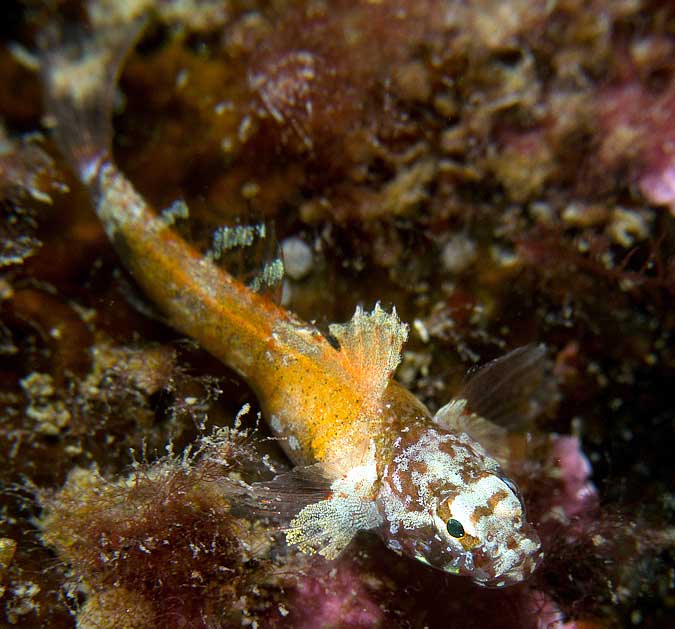PICTURE
GALLERY
Each
month, at least one special marine image will be published from images
sent to the BMLSS. This
can be of the seashore, undersea world or any
aspect of the marine natural world, especially the underwater life, but
not restricted to life beneath the waves. Topical inclusions may be included
instead of the most meritorious, and images will be limited to the NE Atlantic
Ocean and adjoining seas, marine and seashore species and land and seascapes.
Featured
Species

Small
Goby: Lebetus
guilleti
The
ID is in question. It could be a juvenile sculpin,
possibly a young Micrenophrys
lilljeborgii
Photograph
by Jim
Anderson on
a dive in January 2011
in the Sound
of Luing, Inner
Hebrides
This
small fish was originally identified by me as arguably
the most attractive of the gobies found around
the British Isles: Lebetus
guilleti is rarely seen and even more rarely photographed. It has
not even got a popular name. This one had attained its maximum size of
25 mm.
Lebetus
guilleti is a very small fish (possible
the smallest in European seas?) has not been recorded between the tides
around the British Isles, but it is seen mostly in shallow depth at about
10 metres. It inhabits Lithothamnion
alga-encrusted rock areas. There is another species in the genus, Lebetus
scorpioides, that inhabits deeper waters. Lebetus
guilleti has been recorded from
the Shetland Islands
to the Mediterranean Sea.
More
notes:
The
north-eastern Atlantic gobiid genus Lebetus Winther, 1877,
was formerly believed to contain two species, Lebetus scorpioides
(Collett, 1874) and L. orca (Collett, 1874). These have been subsequently
shown to represent females (and immature fish) and males respectively of
a single, sexually dimorphic species whose valid name is L. scorpioides.
The discovery of two forms of Lebetus postlarvae, differing in meristic
characters, fin growth, and pigmentation, is shown not to affect this conclusion
but to suggest provisional recognition of another species, L. guilleti
(Le
Danois, 1913), with fewer anal fin-rays (A I/5–6) and vertebrae (25–26)
than L. scorpioides (A I/7–8; vertebrae 27-29). A key and limited
synonymy for the species is provided. As a possible alternative view it
is suggested that relatively high summer sea-temperatures during early
development of L. scorpioides in certain areas may produce the lower
meristic features of L. guilleti. Dr.
Peter Miller 1971
Guillet’s
Goby - Lebetus guilleti (by Lin Baldock)
Guillet’s
Goby - Lebetus guilleti (by Robert Patzner)
Guillet’s
Goby - Lebetus guilleti (Underwater Shetland)
Jim
Anderson Nudibranch Gallery
Click
on the images for the original photographs
flickr
BRITISH
MARINE LIFE GALLERY
Shorewatch
Biological Recording
Gallery
------------------------------------------------------------------------------------------------------------
Shore
Topography Series
The
name of the particular coast should be included and any other interesting
information including the grid reference, if known. Print photographs can
be included in Exhibitions and on the BMLSS Web
Sites and electronic publications. Electronic images in *.jpg
format can also be considered for the web site. They should not exceed
350K in size.

Inundated
coastline between Bossington
and Porlock Wier,
Somerset
Photograph
by Mark Robinson
The
shingle bar has been breached, with the sea deliberately allowed to flood
the farmland as part of the coastline management. It is envisaged that
the flooded land will revert to salt marsh. This represents a change of
policy where where there are no valuable properties, to allow the natural
dynamic processes is thought to be the best way to manage the coastline.
In part, to allow deliberate flooding in one area prevents flooding in
areas where the sea could cause economic damage.
Flood
Adaptation Action Plan for Porlock Weir
Bristol
Channel Shoreline Management Plan for Porlock Bay
Policy
Decisions for Management of the coast near Porlock Bay
Click
on the images for the original photographs
flickr
British
Coastal Topography
facebook
British
Coastal Topography
----------------------------------------------------------------------------
First
enquiry by EMail to Glaucus@hotmail.com

-----------------------------------------------------------------------

